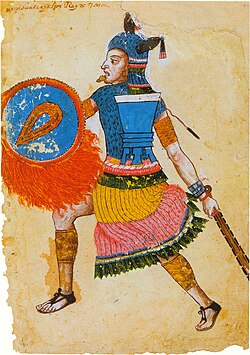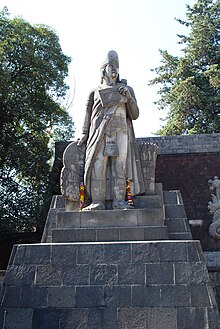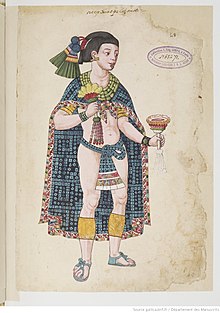Nezahualcoyotl
Nezahualcóyotl, also written as Netzahualcóyotl, (in Nahuatl: Nezahualcoyotl "fasting coyote"; 1402 -1472) was the monarch (tlatoani) of the city-state of Tetzcoco in ancient Mexico and became the main military and political ally of the Mexica, a people to whom he was related on his maternal side, although he is not considered of Mexican ethnicity but Acolhua.
He wielded power and served notably as a poet, scholar, and architect. He was the son of the sixth lord of the Acolhuas, Ixtlilxóchitl (from Nahuatl: Ixtlilxochitl 'dark-faced flower'), lord of the city of Tetzcoco, and the Mexica princess Matlalcihuatzin, daughter of the Mexica tlatoani Huitzilíhuitl, second lord of Tenochtitlan.
At birth, he was given the name Ahcolmiztli (from Nahuatl: strong feline), but the sad circumstances surrounding his adolescence led him to change his name to that of Nezahualcóyotl which means "coyote that fasts", fasting being understood as a form of sacrifice.
Biography
Early Years
Nezahualcóyotl was born in an indigenous year called Ce-tochtli (1-rabbit), which is equivalent to 1402; on a day of their calendar called Ce-mazatl (1-deer), whose widely spread equivalent date is April 28. It is false that Nezahualcóyotl was born on February 4, information that has been attributed to Rafael Tena in his book The Mexica Calendar and Chronography. The book does not mention Nezahualcóyotl at all, much less his birth date. However, this date does not correspond to the Nahua date of the event, the day 1 Mazatl of the year 1 Tochtli, according to modern correlations. Neither do Alfonso Caso's pre-Hispanic calendars help us to correlate the date of birth of Nezahualcóyotl. In short, we do not know for sure what day Nezahualcóyotl was born.
In 1414, when he was barely 12 years old, his father appointed him his successor and they performed the "oath" the Acolhuacan. At the beginning of the XV century, the greatest center of power in the Basin of Mexico was Azcapotzalco, capital of the Tepanecs.
The Tepanec lordship under Tezozómoc had tyrannical overtones, and after a relative military failure, through a palace conspiracy he managed to expel from Tetzcoco and eventually kill Ixtlilxochitl, father of Nezahualcóyotl. Some time later, he had the opportunity to participate in an alliance with the Mexicas, who, in addition to avenging the death of his father, managed to overthrow the Tepanec power.
 Illustration of color (Ixtlixóchitl Codex). |
Once he regained the kingdom, Nezahualcóyotl ruled Tetzcoco. Likewise, he gained a reputation as a sage and gained fame as a poet, although it is true that others considered him a tyrant. His intellectual formation was reflected not only in the architecture of the city, but also in his poetic and philosophical manifestations. Nezahualcóyotl came to build a botanical garden adorned with water pools and aqueducts in Tetzcotzingo, where meetings of poets and intellectuals were common.
One of his descendants, Fernando de Alva Ixtlilxóchitl, came to affirm that even though the Acolhuas professed polytheism, he began to develop the idea of a unique god, which he calls Tloquenahuaque. Several of his verses are currently embodied on the walls of the National Museum of Anthropology in Mexico City.
Texcoco and the Chichimeca War
From his childhood and during his adolescence, Nezahualcóyotl received a very complete education corresponding to his lineage. He studied first in the palace with tutors appointed by his father, and later in the calmécac, a school of higher studies attended by young people from the privileged and ruling classes. In this way he learned writing, the rites and ancestral traditions of his Chichimeca-Toltec ancestors, the history, teachings and doctrines inherited by the Mexicas and Acolhuas who came from the north and the arts of war and politics, which would prepare him for govern his people.
Although Nezahualcóyotl was the born heir to the kingdom of Texcoco, he did not live like a prince surrounded by luxuries and comforts, since in those years his father faced the siege of the Tepanecs of Azcapotzalco, whose warlike king, Tezozómoc, had already conquered Tenayuca and Culhuacán, and he wanted to extend his empire to the northern region of the great lake. Tezozómoc's intention was to assassinate King Ixtlilxóchitl and his entire family in order to seize the throne of Tetzcoco. By then, the Texcocan kingdom was weakened, it did not have committed allies, nor did it have enough weapons or the necessary army to sustain a war and repel the invasion.
In 1418, the Tepanecs besieged the city of Texcoco for 30 days. Under the threat of death launched by Tezozómoc, King Ixtlilxóchitl, wandering and furtive, had to abandon his palace. While Tezozómoc's hosts searched the surroundings of the city to find the Texcocan king and prince, they took refuge in the Cuauhyacac and Tzinacanoztoc caves, surrounded by a few loyalists. Not being able to hide there for long, Ixtlilxóchitl ordered his son to go into the forest, while he and a few men tried unsuccessfully to stop the advance of their captors. However, they anticipated his attack and surprised him in the forest. Prince Nezahualcóyotl, hidden among the branches of a tree, witnessed how his father fought until he was struck down by the Tepanec spears.
Exile
After witnessing the murder of his father, Nezahualcóyotl, just 16 years old, managed to escape and fled. Before him, he had asked his supporters to cease their resistance and, for the moment, submit to Tezozómoc's tyranny, while he sought the support of other peoples and found a way to free them. Once Tezozómoc had completely taken over the city, he ordered the capture of Nezahualcóyotl and offered a reward for whoever delivered him dead or alive; he knew that the rightful crown prince represented a danger as he would try to free the kingdom from him.
From then on and for the next two years, Nezahualcóyotl had to avoid the harassment and snares of his pursuers. Clandestinely, he toured various towns in order to find allies and keep informed of the plans of the usurping king.
For a while he remained undercover in Tlaxcala, where he was able to go unnoticed disguised as a peasant. From there he moved to Chalco and joined the army of the Chalcas as a soldier, but was discovered and locked in a cage. Toteotzinteuctli, the ruler of that city, sentenced him to death to ingratiate himself with the tyrant Tezozómoc.
However, Quetzalmacatzin, brother of the Chalca ruler, took pity on Nezahualcóyotl and helped him escape, changing his clothes and taking his place in the cage. Nezahualcóyotl was able to leave Chalco and return to Tlaxcala without being recognized; Meanwhile, his protector was executed in his place, accused of treason.
Return to Texcoco
It was not until 1420 that this wandering period ended, after Nezahualcóyotl's aunts, his mother's sisters and wives of the rulers of Tenochtitlan and Tlatelolco, asked the Tepanec king for forgiveness for their young nephew. Tezozómoc allowed Nezahualcóyotl to live in Tenochtitlan, a city where the prince without a throne was warmly received.
During the next eight years, thanks to the hospitality of his maternal family, Nezahualcóyotl was able to continue his education and military training, which allowed him to quickly become a warrior; in the same way he cultivated his vocation for the arts and sciences. In those years, Tezozómoc granted him a palace in Tetzcoco and authorized him to travel between the two cities. However, Nezahualcóyotl had not forgotten the events that led to his exile. Determined to reclaim the throne from him, he strategized to accomplish his goal. By then, the old Tezozómoc, weakened and seriously ill, suspected Nezahualcóyotl's intentions and, almost on the verge of death, entrusted his three sons Maxtla, Teyatzin and Tlatoca Tlitzpaltzin to assassinate the dethroned prince.
Nezahualcóyotl, aware of the plans of his enemies, took refuge in Tenochtitlan under the protection of his uncle, King Chimalpopoca. A year later, Tezozómoc died, and Maxtla took his place as ruler of Azcapotzalco. Although he knew the purpose of assassinating him, Nezahualcóyotl attended the funeral of the Tepanec patriarch. Tezozómoc's heir was not willing to cede the throne of Tetzcoco to Nezahualcóyotl, and decided to take Chimalpopoca prisoner in retaliation against him for having helped his enemy; at the same time, he sent a group of mercenaries to find and execute the reckless prince.
Nezahualcóyotl, defying danger, arrived in Azcapotzalco to intercede for the freedom of Chimalpopoca. Maxtla pretended to be benevolent, but treacherously tried to assassinate him. Nezahualcóyotl managed to escape unharmed and escaped to Tetzcoco. Then Maxtla prepared a new trap to eliminate it. He convinced Yancuiltzin, natural son of Nezahualcóyotl's father, to invite his half-brother to a banquet and once he was alone in his house, kill him. However, Nezahualcóyotl is warned of the sinister plan by a friend and, to escape death, arranged for a peasant to pose as him to attend Yancuiltzin's banquet. There, the supposed Nezahualcóyotl is beheaded and his head was delivered as a trophy to Maxtla, who believed that he had finally finished off the invincible prince. However, he soon found out that Nezahualcóyotl was still alive. Enraged, Maxtla gave orders to his main captains to go to Tetzcoco in search of Nezahualcóyotl and annihilate him mercilessly.
Attack by Maxtla
Once again, the Texcocan prince had to flee from fierce persecution. On multiple occasions he managed to escape unscathed from the ambushes ordered by Maxtla. Unable to catch up with his elusive opponent, he unleashed his revenge against Chimalpopoca and treacherously assassinated him, which would give a drastic turn in favor of Nezahualcóyotl, because the Mexicas, outraged, decided to break their alliance with Azcapotzalco and named Izcóatl as their new king. This led to Tenochtitlan being besieged by Maxtla.
Meanwhile, with great diplomatic skill, Nezahualcóyotl managed to attract the favors of other cities dissatisfied with the Tepanec tyranny and organized a common front, whose main weight fell on the Tlaxcalans and the Huejotzincas. The formidable allied army achieved victories at Otumba and Acolman before taking Texcoco in 1429.
Nezahualcóyotl immediately dedicated his efforts to liberating Mexico and Tlatelolco. In a bloody battle, he destroyed Azcapotzalco after a siege of one hundred and fourteen days. Maxtla died at the hands of Nezahualcóyotl, who, willing to inaugurate a period of splendor in the Valley of Mexico, managed to seal a confederal pact with Itzcóatl, of Tenochtitlan and Totoquihuatzin, lord of Tlacopan, a pact known as the Ēxcān Tlahtolōyān.
Death and descendants
When Nezahualcóyotl died in 1472, his son Nezahualpilli ascended the throne, who ruled the city until 1516, continuing the expansive policy undertaken by his predecessor. His grandson Ixtlilxóchitl II started a war against his brother Cacamatzin and allied with the Spanish conquistadors. He also participated in the Siege of Tenochtitlan.
After the conquest of the Mexica Empire, another of his grandsons, Juan Bautista de Pomar, obtained one of his grandfather's noble houses in Texcoco and wrote a history with the intention of claiming his rights to his grandfather's legacy. He was also a Novohispanic nobleman, writer and historian, and the creator of one of the most important works of Nahuatl poetry, Romances de los señores de Nueva España . One of Ixtlilxóchitl II's great-grandsons, Fernando de Alva Ixtlilxóchitl, was a distinguished student at the Colegio de la Santa Cruz de Tlatelolco and, in 1612, was appointed indigenous governor of Texcoco, and the following year, of the town of Tlalmanalco.
Works during his government
The government of Nezahualcóyotl not only represented a model of government and administration, the king also undertook extraordinary construction and architectural projects in Tetzcoco and Tenochtitlan. He had a special interest in service and ornamental works, for which he built dams, aqueducts, palaces, temples, monuments, roads and gardens.
Thanks to his aesthetic vision, he sought to harmonize the requirements of urban systems with the natural conditions of the environment. In addition to directing the urbanization of his kingdom, he had more than four hundred houses and palaces built for the lords and knights of his court, each according to the rank and merits of its inhabitant. Among the great works carried out by Nezahualcóyotl is the Templo Mayor de Texcoco that was dedicated to Huitzilopochtli and Tláloc, whose upper terrace was ascended through 160 steps.
City beautification, botanical garden and zoo
Motivated by his love for nature, in the forests of Tezcutzingo and Chapultepec, his favorite recreation spots, he preserved the springs and trees, led the water through the mountains, introduced irrigation, carved ponds and pools in the formations rocky, planted flowers, propagated various animal species and ordered the construction of a zoo and a botanical garden. Likewise, the famous gardens of his superb palace stand out, as well as the portentous aqueduct erected in the Chapultepec forest to supply drinking water to Tenochtitlan.
Dike of Nezahualcóyotl
His greatest work, at the request of his counterpart and ally Moctezuma I, was a large stone and wood dam (which the Spanish called “the great albarradón”) that extended for more than 16 km, which served as a defense against the floods that affected that city, and that also prevented the mixing of the salt water and the fresh water of the great lake. This great work earned him the reputation of best architect of the Americas.
New discoveries about the "coyote" or "wolf"
Recently it has been speculated that the Nahuatl word, coyotl, could actually refer to the wolf and not the coyote. This is mainly based on the discovery of a ritual deposit in offering number 126 of the Museo del Templo Mayor. In this, 9,000 animal bones have been found, among them at least bones of 20 wolves. These animals were of all ages and even with degenerative diseases associated with old age, which indicates that the animals were cared for until an advanced age beyond their wild life expectancy, this in the famous Tenochtlitlan Zoo.
According to archaeologist Ximena Chávez Balderas, many of the representations in the codices are not coyotes but wolves:
I have spoken with many biologists about representations and say that morphologically some seem rather wolves, so I think that The researchers have interpreted all these representations as coyotes, when in fact some may correspond to wolves.Ximena Chávez Balderas.
Tributes
To honor the memory of this illustrious pre-Hispanic monarch, a fountain has been dedicated to him in Chapultepec Castle, designed by artist Luis Ortiz Monasterio. Likewise, the work of Federico Cantú at the Autonomous University of Nuevo León, in addition to naming a municipality and a city in the State of Mexico with his name.
Similarly, at the National Autonomous University of Mexico, the Nezahualcóyotl Room was erected with his name.
In the Spanish city of Cáceres there is a statue in his honor.
His image appears on the 100 Mexican peso bills, accompanied by one of his best-known poems.
In 2005 his name was inscribed in gold letters on the wall of honor of the Chamber of Deputies of the Mexican Congress.
In the municipality of Texcoco, his birthplace, a monument was built to him, as well as some schools.
In the act to commemorate the International Day of the Mother Language, held on February 21, 2013 at the National Museum of Art, the General Directorate of Popular Cultures of the National Council for Culture and the Arts, by Miriam Morales Sanhueza, presented the free application for iPad dedicated to the poetic work of Nezahualcóyotl: it includes 38 poems that can be read in Nahuatl and Spanish. Also included was a digital facsimile of the first preserved transcriptions of Nezahuacóyotl's pre-Hispanic chants and a comic about his life. The application includes a multimedia section with interviews with Miguel León-Portilla and Patrick Johansson.
Poetry
Known as the "Poet King," Nezahualcóyotl wrote numerous poems that are said to be preserved in the Old Library of Texcoco, among them the best known is the following:
I love cenzontle singing,
bird of the four hundred voices.
I love the jade color,
and the enervante perfume of the flowers,
But what I love most is my brother,
the man.
The above is the poem that the Mexican government published next to an effigy of Nezahualcóyotl, on most 100-peso bills, at the end of the last decade of the century XX, however, investigation indicates that he may not be the author of this poem, and that many more that he wrote are unknown.
Contenido relacionado
Palestinian National Authority
Mesolithic
Moeris




